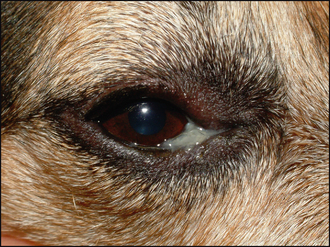12 Medial canthal pocket syndrome
CLINICAL EXAMINATION
General clinical examination is normal. On ophthalmic examination all neurological tests are normal and the eyes are open and comfortable. Schirmer tear test readings are normal. The most obvious feature is a discharge at the medial canthus and some localized conjunctival hyperaemia (Figure 12.1). The bulbar conjunctiva is normally only very slightly hyperaemic whereas the ventral palpebral and nictitans conjunctiva can appear very inflamed. The discharge is bilateral but not necessarily totally symmetrical. Some discharge is seen within the ventral fornix, in a pocket formed by the gap between the eyeball and the lids (due to the relative enophthalmos inherent in the breed conformation). Follicles can be noted within the conjunctiva close to the discharge on cleaning it away. No corneal pathology is normally encountered but a mild ventral entropion is sometimes seen. Intraocular examination is unremarkable.

Figure 12.1 Typical grey–white mucoid accumulation at the medial canthus in a collie/German shepherd cross (XGSD).



